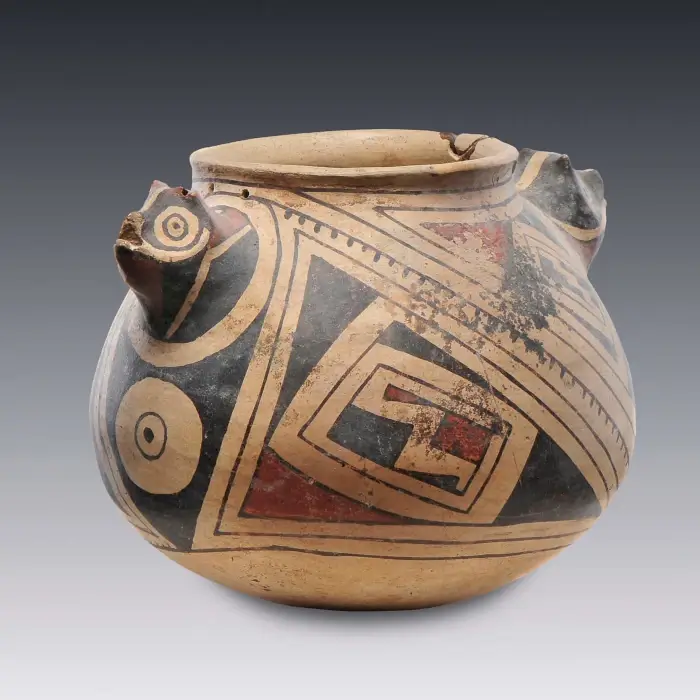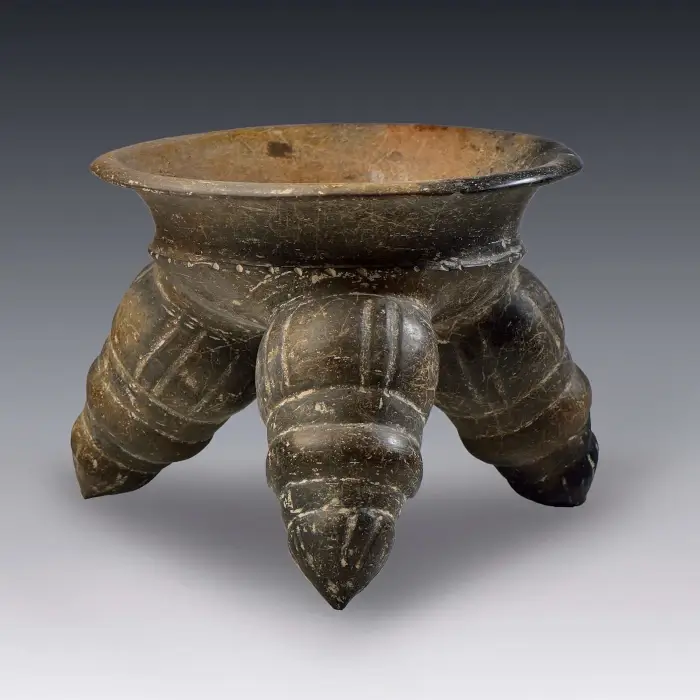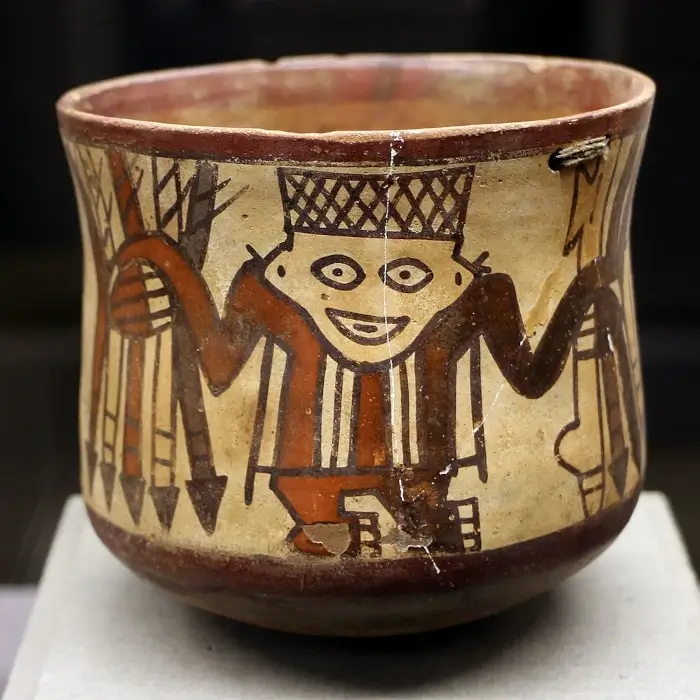The fascinating handcrafted beauty of Nariño’s ceramics
The pottery of Nariño is a tangible testimony to the rich cultural heritage of present-day Colombia, where the pottery tradition dates back centuries. With a stylistic diversity ranging from complex negative decoration to sophisticated gilding techniques, this pottery reflects the advanced social organization and artistic skill of the region’s pre-Hispanic societies.
I invite you to explore the evolution, variety and cultural significance of these masterpieces, which not only adorn but tell the story of a people.

Origins and Evolution of Nariño’s Ceramics
Pottery in Nariño is a reflection of the deep cultural roots and artistic mastery developed over centuries. From its origins, marked by the creation of utilitarian and decorative pieces through manual techniques such as the rolling of clay strips, to the introduction of the potter’s wheel that revolutionized production, allowing the elaboration of more symmetrical and refined pieces. The evolution of pottery in this region not only evidences the adaptation of techniques and tools, but also the influence of diverse cultural and artistic currents.
The diversity of styles in Naríñan ceramics, which we will explore below, is testimony to this rich pottery tradition. Each piece tells a story, from the simplicity of the earliest designs to the ornamental complexity of later times, revealing not only technical advances but also the constant dialogue between ceramics and their cultural and social context.
Innovation and sustainability are current characteristics of pottery in Nariño, where tradition merges with contemporary approaches. This aspect, together with the rich diversity of styles and cultural depth of Nariño pottery, demonstrates the continuous evolution of this ancient art.
Diversity of Styles in the Ceramics of Nariño
Naríñense pottery, rooted in the pre-Columbian traditions of the northern Andes, is distinguished by its rich variety of styles and techniques, a legacy of the Valdivia and Puerto Hormiga cultures. Predominant characteristics include iridescent and negative painting, the use of molds and the creation of pieces with handles and whistles, demonstrating a remarkable artistic evolution over the centuries.
Among the main pieces are utilitarian pieces such as bowls, jars and vessels, as well as anthropomorphic figures that reflect aspects of daily life, rituals and the rich symbolism of their creators. These works were not only functional elements but also possessed a deep cultural meaning, accompanying the dead in their tombs or used in ritual ceremonies.
The influence of the Nariño culture is notable, especially for its rectilinear geometric designs in black on dark red and the anthropomorphic figures that often represent shamans or individuals in funeral rituals, suggesting a deep connection with the spiritual world and nature. This legacy continues to enrich the contemporary art scene, fusing tradition and innovation.
Varieties and Functions of Nariño pottery
Nariño ware, known for its rich cultural heritage, presents a variety of forms and styles, reflecting the diversity of the Colombian Andean region. From 800 to 1500 A.D., the Nariño culture was characterized by its distinctive pottery with rectilinear geometric designs in black on a dark red background.
These pieces not only fulfilled utilitarian functions in everyday life, as vessels for storing and consuming food and beverages, but also played a crucial role in rituals and religious ceremonies, underlining both their practical and symbolic importance.
Nariño pottery is distinguished by its adaptability and innovation, integrating advanced production techniques, such as the use of the potter’s wheel, which allowed for greater symmetry and uniformity in the pieces. This technical evolution not only raised the quality of Nariño pottery, but also enriched it aesthetically, giving it an outstanding presence in the artistic panorama of the region.

Buy pre-Columbian ceramics
Find original pieces and also reproductions identical to the traditional ceramic works that were made in pre-Columbian America and that are only found in museums, making them affordable.
Today, Nariño pottery continues to be a vibrant reflection of the region’s cultural identity, fusing tradition with innovation. Contemporary artisans continue to explore new forms and techniques, keeping alive the rich pottery tradition while adapting their creations to modern demands and tastes. This section opens the way for a broader discussion on the cultural role of ceramic crafts in Nariño and how innovation and sustainability are shaping the future of this ancient practice.
The Cultural Role of Ceramic Handicrafts in Nariño
Ceramic handicrafts in Nariño are not only an expression of technical skills, but a pillar of the cultural identity of the region. Each piece reflects the history, cosmology and social practices of its communities, being a living legacy of ancestral knowledge transmitted from generation to generation. These pieces, more than utilitarian objects, are symbols of community unity and cultural continuity, playing a fundamental role in ceremonies and festivities.
The connection between handicrafts and the social fabric of Nariño is evident in the way these works foster social cohesion. By participating in the creation of ceramics, artisans and their communities reaffirm their belonging and respect for traditions. Likewise, ceramic crafts serve as a bridge between the past and the future, adapting to modern changes without losing their essence, which anticipates a focus on innovation and sustainability in Nariño’s ceramic production.
Innovation and Sustainability in the Ceramic Production Naríñense
In Nariño’s ceramic production, innovation and sustainability have become central to preserving the artisanal legacy without compromising natural resources. The adoption of renewable energies for kiln operation and the use of local and natural materials for clays and glazes are practices that minimize the ecological footprint of this ancient activity.
These changes not only reduce environmental impact, but also add value to each piece, reflecting a commitment to the planet.
Alternative firing methods, such as raku and pit firing, emerge as less energy-intensive options than traditional kilns, while offering unique textures and finishes that enrich the aesthetic diversity of Nariñense ceramics.

Where was each pre-Columbian culture?
Check our interactive map to see its period and location.
Reuse and recycling in the workshop, together with the upcycling of discarded materials, are practices that demonstrate a conscious management of resources and promote a circular economy in the handicraft sector.
Sustainability in ceramic production is not only limited to environmental aspects, but also involves the preservation of traditional techniques and the transmission of knowledge between generations. This balance between innovation and respect for tradition ensures that Nariño’s rich ceramic heritage continues to flourish, adapting to new challenges without losing its essence.
The sustainable practices in Nariño ceramics are a model to follow, demonstrating that it is possible to honor the artisanal past while embracing a greener and more responsible future.





